Oceaning: Governing marine life with drones Adam Fish
Visit to download the full and correct content document: https://ebookmass.com/product/oceaning-governing-marine-life-with-drones-adam-fis h/
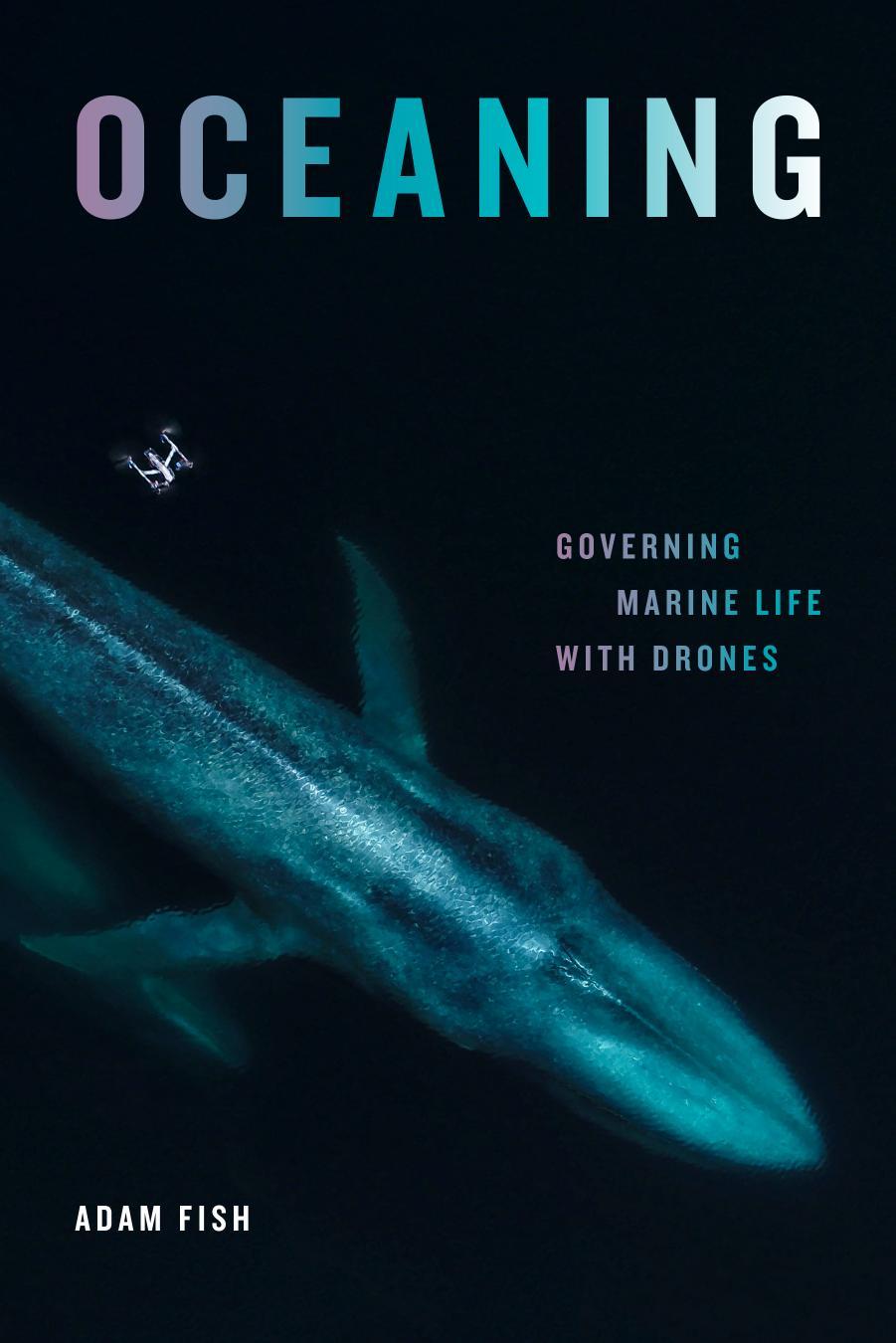
More products digital (pdf, epub, mobi) instant download maybe you interests ...

DIY Drones for the Evil Genius: Design, Build, and Customize Your Own Drones: Design, Build, and Customize Your Own Drones Ian Cinnamon
https://ebookmass.com/product/diy-drones-for-the-evil-geniusdesign-build-and-customize-your-own-drones-design-build-andcustomize-your-own-drones-ian-cinnamon/

The I Love My Life Challenge: The Art & Science of Reconnecting With Your Life, A Breakthrough Guide To Spark Joy, Innovation, and Growth Adam Markel
https://ebookmass.com/product/the-i-love-my-life-challenge-theart-science-of-reconnecting-with-your-life-a-breakthrough-guideto-spark-joy-innovation-and-growth-adam-markel/

Infinity Fish : Economics and the Future of Fish and Fisheries Ussif Rashid Sumaila
https://ebookmass.com/product/infinity-fish-economics-and-thefuture-of-fish-and-fisheries-ussif-rashid-sumaila/

The Greek Life of Adam and Eve 1st Edition John R. Levison
https://ebookmass.com/product/the-greek-life-of-adam-and-eve-1stedition-john-r-levison/

Pleading the Fish Bree Baker
https://ebookmass.com/product/pleading-the-fish-bree-baker/
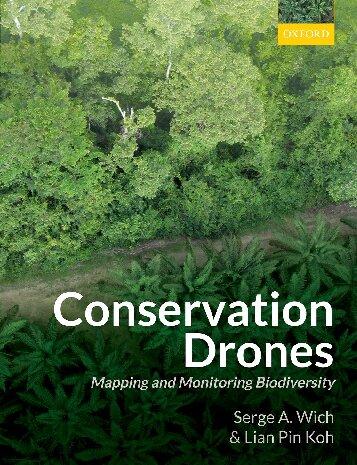
Conservation Drones Mapping and Monitoring Biodiversity
Serge A. Wich
https://ebookmass.com/product/conservation-drones-mapping-andmonitoring-biodiversity-serge-a-wich/
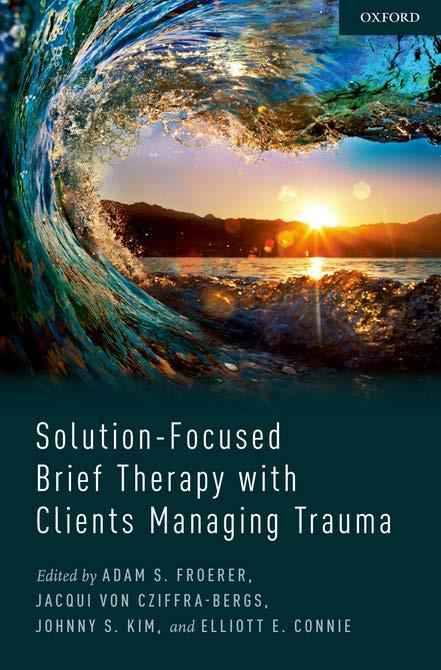
Solution-focused brief therapy with clients managing trauma Adam S. Froerer
https://ebookmass.com/product/solution-focused-brief-therapywith-clients-managing-trauma-adam-s-froerer/

Fish Out of Water Katie Ruggle
https://ebookmass.com/product/fish-out-of-water-katie-ruggle/

Nutritional Fish and Shrimp Pathology: A Handbook (European Association of Fish Pathologists (Eafp) / 5m Books Series) Tran
https://ebookmass.com/product/nutritional-fish-and-shrimppathology-a-handbook-european-association-of-fish-pathologistseafp-5m-books-series-tran/
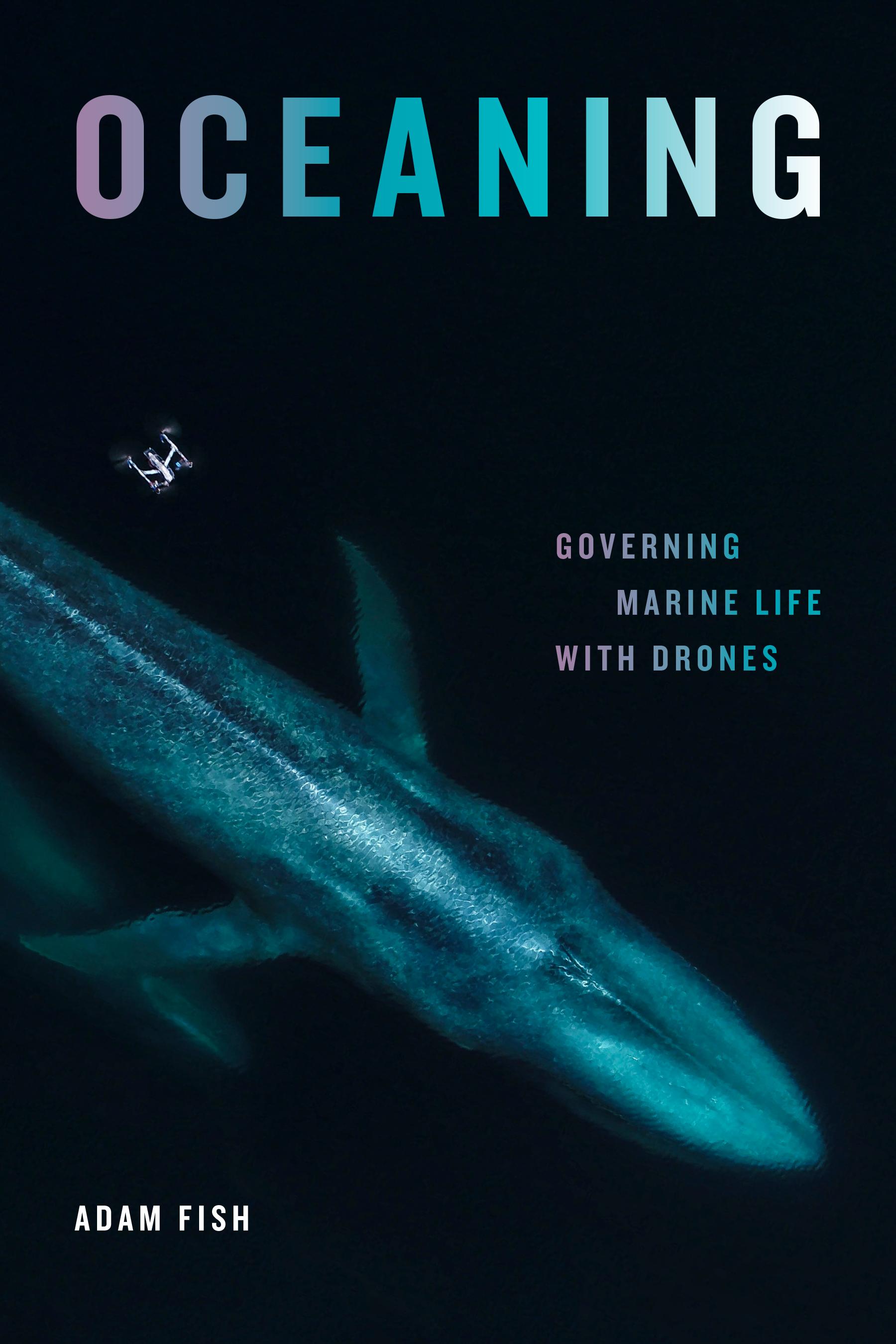
Elements A series edited
by Stacy Alaimo and Nicole Starosielski
GOVERNING MARINE LIFE WITH DRONES
© 2024 Duke University Press
All rights reserved
Printed in the United States of America on acid- free paper ∞
Project Editor: Michael Trudeau
Typeset in Chaparral Pro and Knockout by BW&A Books, Inc.
Library of Congress Cataloging- in- Publication Data
Names: Fish, Adam, [date] author.
Title: Oceaning : governing marine life with drones / Adam Fish.
Other titles: Elements (Duke University Press)
Description: Durham : Duke University Press, 2024. |
Series: Elements | Includes bibliographical references and index.
Identifiers: LCCN 2023018773 (print)
LCCN 2023018774 (ebook)
ISBN 9781478030010 (paperback)
ISBN 9781478025801 (hardcover)
ISBN 9781478059011 (ebook)
Subjects: LCSH : Marine biology—Research—Technological innovations. | Oceanography—Research—Technological innovations. | Marine sciences—Research—Technological innovations. | Drone aircraft in remote sensing. | Marine biology—Remote sensing. | Marine sciences—Remote sensing. | Oceanography—Remote sensing. | Information storage and retrieval systems—Marine biology. |
BISAC: SCIENCE / Environmental Science (see also Chemistry / Environmental) | NATURE / Ecosystems & Habitats / Oceans & Seas.
Classification: LCC GC 10.4.R 4 F 574 2024 (print) | LCC GC 10.4.R 4 (ebook) | DDC 577.7028/4—DC 23/ENG /20231018
LC record available at https://lccn.loc.gov/2023018773
LC ebook record available at https://lccn.loc.gov/2023018774
Cover art: Photograph © Christian Miller / Ocean Alliance
This book is dedicated to my daughter, Io, the most reluctant nipper.
This page intentionally left blank
This page intentionally left blank
ACKNOWLEDGMENTS
During the fieldwork for this book (2015–22), I became a drone pilot, logging over a hundred hours of flight time in locations around the world: the United Kingdom, Iceland, Denmark, United States, Indonesia, Sri Lanka, and Australia. You could say I was seduced by the techno-utopian discourse of entrepreneurs like Chris Anderson, who left the editorship at Wired magazine to start the drone company 3d Robotics and evangelized: “We are as yet tourists in the air, briefly visiting it at great cost. By breaking the link between man and machine, we can occupy the skies” (C. Anderson 2017). Anderson’s aspiration resonated with icons in my development: Stewart Brand’s Whole Earth Catalog, Jacques Cousteau’s marine conservation, Carl Sagan’s vision of our interplanetary future— my thanks go to my mother, Jennifer Fish, for exposing me to these visionaries at a young age. Such early influences coalesce in this book on human- scale technology, the ocean, and becoming a mature planet.
My first drone experiment from 2015 to 2017 was designed to enhance “infrastructural literacy” (Parks 2009) by creating a visual travelogue of the undersea fiber- optic system that connects Iceland, the United Kingdom, and Denmark. The discoveries from this research foreshadowed findings in Oceaning namely, that drones are entangled by what they engage and conditioned by the environments through which they fly. We lost control of a drone because of its reaction to magnetic fields emitted from black sand beaches in Iceland (or so we imagined), and I witnessed the communicative parallels between the networked technologies of drones and the sonar of pilot whales in the Faroe Islands. These flights and crashes showed the elemental contingencies of exploration (Fish and Garrett 2019; Fish, Garrett, and Case 2017a, 2017b; Garrett and Fish 2016). My appreciation goes out to Dr. Bradley L. Garrett for partnering in these and other projects and for introducing me to drone piloting. Páll H. Vesturbú was instrumental in visiting the internet’s points of presence in the Faroe Islands. A visiting professorship at the University of Iceland, courtesy of Hafsteinsson Sigurjón, grounded me during the fieldwork in 2015.
A Leverhulme Trust Research Fellowship (2017–18), in the UK, enabled me to conduct ethnographic work into drone culture in northern Europe, Indonesia, and Sri Lanka. At the time, I was faculty at Lancaster University in the sociology department, a conducive place to study the politics of science and technology. My sincere thanks go out to Dr. Monika Buscher, Dr. Tim Dant, Dr. Bulent Diken, Dr. Bruce Bennett, Dr. Graeme Gilloch, Dr. Adrian Mackenzie, Dr. Corinne May- Chahal, Dr. Lucy Suchman, Dr. Imogen Tyler, Dr. Claire Waterton, Dr. Benjamin Neimark, Dr. Luca Follis, Dr. Karolina Follis, Dr. Brian Wynne, and Dr. John Urry. Releasing a video- enabled helium balloon with Dr. Bronislaw Szerszynski and somehow finding it in a backyard a hundred kilometers away was typical of the type of experimentation encouraged at Lancaster University. The Centre for Mobilities Research, the Institute for Social Futures, Security Lancaster, and the Faculty of Arts and Social Sciences at Lancaster University, as well as cost : European Cooperation in Science and Technology, deserve thanks for being early supporters of this scholarship.
During 2018–19, I navigated with drone inventors, humanitarians, and environmental activists as they piloted drones during crises. Environmental and land-rights advocates in West Papua, Indonesia, steered drones to record riverbank erosion caused by palm oil plantations. They documented their traditional arboreal gardens and surrounding peat swamps— all preemptive efforts to map their lands before the plantation owners rolled into the area, demanding land concessions. I assisted these operations, bringing pilots and engineers together with local activists and drones (Fish and Richardson 2022; Fish 2023). As a documentary filmmaker, I saw the immense possibility in this flying camera, while as an activist, I recognized how the drone could be a tool for radical transparency, a way to peer down into what geographer Doreen Massey (2004) calls the geographies of responsibilities and power. As an anthropologist, I was witnessing the emergence of a multisited public of cultural production, science, and technology. I would like to thank Dr. Irendra Radjawali and Hagorly Hutasuhut, both of the Bandung Institute of Technology, for their efforts in enlightening me about the potentials of atmospheric technologies in Indonesia.
While we were in Indonesia, the Agung volcano on the island of Bali erupted, and Aeroterrascan, an Indonesian drone company I was working with, donated their time, personnel, and technology. We operated drones over the volcano and looked into the crater to ascertain the severity of the eruption. What we saw encouraged the government to relocate sev-
x • acknowledgments
In Sri Lanka, I worked alongside conservationists defensively arming local farmers with drones so that they might frighten marauding Asian elephants ( Elephas maximus) away from their fields and homes, saving themselves, their livelihood, and the elephants from a more lethal deterrent. The team at the Sri Lanka Wildlife Conservation Society, in particular Chandima Fernando, provided key insights into the potentials for drones in conservation.
The ideas in this book came together in the urban centers of Germany during a senior research fellowship at the Weizenbaum Institute for the Networked Society, at the Technische Universität Berlin, with Dr. Stefan Ullrich from 2018 to 2019 and a research fellowship at the Zemki Centre for Media, Communication and Information Research, University of Bremen, with Dr. Andreas Hepp in 2018. During this time I was fortunate to receive invitations from Dr. Johan Lindquist to speak at the University of Stockholm, Department of Social Anthropology; Dr. Tora Holmberg at Uppsala University, Department of Sociology; Dr. Patrick Vonderau at the University of Halle-Wittenberg; Dr. Paula Bialski and Dr. Götz Bachmann, then at Luephana University; and Dr. Philippa Lovatt at St. Andrews University. Helping to refine this book’s concepts were additional talks at the News and Media Research Centre, University of Canberra; the Mobile Life Center at the Stockholm University; Technologies in Practice Research Group at the it University of Copenhagen; the Social Anthropology Department at the University of Edinburgh; and the Institute for Advanced Studies in the Humanities and Social Sciences, National Taiwan University. I would like to express my gratitude to Dr. Beryl Pong for inviting me to give a keynote at the National University of Singapore’s New Technologies Research Academy.
In 2019, I accepted a research position at the University of New South Wales, a university near the surprisingly undomesticated urban shoreline of headlands, bays, and beaches of Sydney, New South Wales, Australia. This book’s conceptual framework began to concretize in Australia, where I found a research ecology steeped in environmental humanities and an ethnographic approach to multispecies studies (Van Dooren 2014; Rose 2011; Plumwood 2001). Sharks regularly patrol the shores while whales
acknowledgments • xi enty thousand people away from the epicenter. Later, I elevated drones over coral reefs in Bunaken National Marine Park in Sulawesi, Indonesia, documenting coral bleaching. Throughout these missions folks at Aeroterrascan—Dian Rusdiana Hakim and Feri Ametia Pratama—were generous with their time and my inadequate Bahasa Indonesia.
migrate north and south, and the coral of the Great Barrier Reef is two days’ drive north. These animals are not distant specimens but strangely perceptible, in reach and in sight— perhaps too close for some. In Australia I have been fortunate to hang with drone- curious academics Dr. Edgar Gomez Cruz and Dr. Michael Richardson, who provided beachside opportunities for critical reflection on the purpose and potentials of these new technologies. The University of New South Wales’s Scientia Fellowship program and Dr. Michael Balfour, in particular, generously provided me with the time to conduct this fieldwork, write this book, and participate in artist residencies. As I explored the drone’s videographical capabilities, it became as much a writing as an artistic project. I was fortunate to work with two clans of brilliant artists at the Four- plus one: the Elements, Kinono Artist residency in Tinos, Greece, in May 2022 and the Field_Notes-The Heavens, Bioart Society, Kilpisjärvi Biological Station in Lapland/Finland, in September 2019. My thanks go out to the Open Eye Gallery in Liverpool, UK, for screening my film Organic Machine (2020) in January 2022 as part of the Look Climate Lab. I acknowledge those who screened my documentary Crash Theory (2019) about tumbling drones and collapsing ecologies. Likewise, I celebrate those who brought our Points of Presence (2017) documentary on information infrastructure in the North Atlantic, produced with Bradley L. Garrett and Oliver Case and music by Jon Christopher Nelson.
In Australia, I launched into a public of ocean drone hobbyists, scientists, entrepreneurs, and activists. I began conversing with people like Dr. Vanessa Pirotta, a marine biologist at Macquarie University who collects whale breath with drones; Jonathan Clark (of the Sea Shepherd Conservation Society in Australia) and Andre Borell (shark activist and filmmaker), who both advocate for the use of drones to alert swimmers of sharks’ presence instead of using nets and hooks to kill and capture sharks; Gary Stokes, who flies drones and identifies illegal shark fishing in Timor-Leste and ghost nets near Hong Kong; Nora Cohen, previously of the Obama White House and now of Saildrone in San Francisco; and Dr. Karen Joyce, a coral drone scientist who started the crowdsourcing drone platform Geonadir. My thanks go out to these scientists and activists for their efforts in conservation and in enlightening me about their work.
Through interviews, I began to investigate the Sea Shepherd Conservation Society’s long history of atmospheric and oceanic technologies in acts of direct action on the open seas. Their numerous television
xii • acknowledgments
The ideas in this book have diffused across various other projects. Chapters 2 and 5 are particularly indebted to my 2022 article “Saildrones and Snotbots in the Blue Anthropocene: Sensing Technologies, Multispecies Intimacies, and Scientific Storying” in Environment and Planning D: Society and Space 40, no. 5 (October): 862–80; chapter 3 to my 2022 article “Blue Governmentality: Elemental Activism with Conservation Technologies on Plundered Seas” in Political Geography 93, art. no. 102528 (March): n.p.; and chapter 6 to my 2021 article “Crash Theory: Entrapments of Conservation Drones and Endangered Megafauna” in Science, Technology, and Human Values 46, no. 2 (March): 425–51. Gratitude to the editors and peer reviewers for the help on those articles.
Much appreciation for the conceptual assists given by Sarah Jane O’Brien, Courtney Berger, Nicole Starosielski, Stacy Alaimo, and Michael Trudeau. A hearty thanks goes out to my wife, Robin Fish, for enduring these escapades, for caring for our home and daughter, Io, when I was away, and for our partnership across these continents.
acknowledgments • xiii programs and feature-length documentaries reveal the innovative and sometimes terrifying applications of conservation technologies in the Southern Ocean to defend Antarctic minke whales (Balaenoptera bonaerensis) and the vaquita porpoise (Phocoena sinus) in the Sea of Cortez, Mexico. Dr. Pirotta’s use of drones led me to Ocean Alliance, founded by Dr. Roger Payne, famous for his studies of humpback whale songs. I discovered through several conversations that, like Sea Shepherd, Ocean Alliance had long used a wealth of different technologies to get closer to and know more about whales. Shifting from shooting a crossbow at a whale to collecting skin and blubber samples, Ocean Alliance and their chief scientist, Dr. Iain Kerr, navigate drones to fly through the stinky exhalation of whales. To expand my understanding of how different drone technologies are affected by the elements, I visited the National Oceanic and Atmospheric Administration in Seattle and spoke with oceanographers Dr. Calvin Mordy and Dr. Carey Kuhn, who direct semiautonomous sea surface drones toward northern fur seals. I thank them and the many other drone pilots with whom I talked for their help in this project.
This page intentionally left blank
BEGINNING
INTIMACIES OF CONSERVATION TECHNOLOGY
CATCHING A WHALE
Catching a humpback whale ( Megaptera novaeangliae) is difficult. Seeing the spurt of its exhale, illuminated by the sun over a seaside cliff on a windless morning, is the easy part. From the eastern suburbs of Sydney, New South Wales, Australia, my eyes— first naked, then with binoculars— spot a humpback whale near south Bondi Beach, about two kilometers away, heading north. Monitor in hand, fingers on levers, heavy first- person viewing (fpv ) goggles fitted around my head, I launch the drone on a long flight toward the splashing whale.
For five or so minutes, four razorlike propellers imperceptibly spin, temporarily lift, and carry an assortment of hardware, software, sensors, lenses, storage systems, and valuable footage. For this period, all that matters is staying aloft, not injuring another being, and executing the mission—to fly near a whale and film its behavior. Piloting the drone with fpv goggles is disorienting. On this sandstone cliff above a high tide, I get dizzy. I sit, then lie down, trying to calm my breathing. The
water world inside the goggles is vibrant, detailed, and strangely peaceful. I scan the screen for little white bursts of a whale breathing or, better yet, breaching. Schools of Australian salmon ( Arripis trutta), bottlenose dolphins (Tursiops aduncus), and jumping yellowtail kingfish (Seriola lalandi) swirl by as I travel to the whale; a dolphin mother turns to her side to take a closer look at the drone, redirecting her calves away from the buzzing, flying camera.
If I get there in time and the whale, weather, and technology coordinate, I might be able to capture video of a living whale. This spectacular video could document an individual, as whales are tracked by marine biologists according to the distinctive patterns on their flukes. Perhaps this whale has been photographed before by onlookers on a tour boat, another drone operator, or a whale scientist, and its images have made their way into an archive of whale pictures. Aided by artificial intelligence, this footage could be compared to a geographical database of whale flukes and might contribute to understanding this whale’s migration. This is what I dream as I race at forty kilometers an hour over the sea, scanning for cracks in the blue horizon.
Suddenly, one kilometer away, the drone’s connection to the remote control and goggles evaporates. The screen freezes, shifts to black and white, and goes blank. The drone is disconnected, hovering in place, or so I pray. This has happened countless times before, for reasons I’ll never understand, and all I can do is hope it will find its way home. Otherwise, it has fallen and drowned, and with it the footage of the dolphins and fish, and no whale today. I resist the desire to take off the bulky headset; there is no point. The drone is too far away to see with my unaided eyes. So I sit in dark sensory deprivation, the once kaleidoscopic colors inside the goggles now an ebony void, listening.
Tension gives way to relief when I hear the propellers buzzing high above. Following its safety protocol, the drone automatically returns to where it departed, beside me on a headland of chalky sandstone. It lands with an alien precision. Emerging from the cavern of augmented reality, I take a deep breath and turn around to see that the whale— or at least its exhale— is still in sight. Joyful gasps and pointing fingers of a nearby couple reassure me that it remains in the neighborhood. With the exchange of a fresh battery, the goggled monitor returns to its multihued pixels, and I try to ignore the earlier threat of the drone sinking.
Zipping out to sea again, I follow the whale’s pectoral fins as they beckon with playful waves. I make it. One hundred meters above the
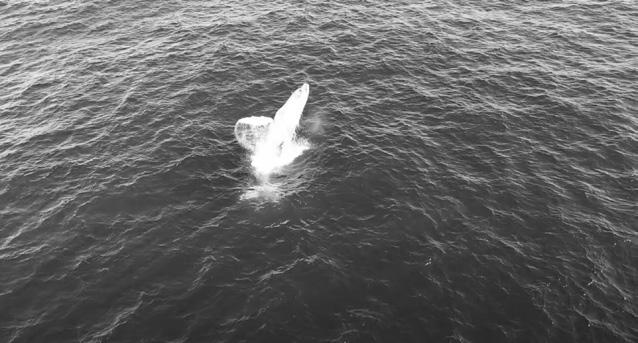
whale, I begin to record video, coordinating my piloting with its swimming. It dives. Its massive blue- black body fades to green and, as it turns underwater, it exposes its white underbelly and callosities before disappearing. Then, building force from the depths, it begins its breach (figure 1.1). Puncturing the surface with its full body, it appears to hover in the air before collapsing with a burst of white water. It is too far away to hear, but I imagine the sound of the thirty-ton animal smashing the sea. What I actually hear is the crashing of waves against the cliff below. Drone piloting is an experience not of disembodiment but of double embodiment— a seeing there and a being and hearing here. It is disorienting and profound.
My onshore body is barely mobile and slightly nauseated. Adrenaline soars, fingers twitch, and eyes patrol the digital seas. The drone stops recording; the memory card is full, complete with ten minutes of stunning footage of a whale slapping, diving, and porpoising or peeking out from the watery depths. It could be communicating, playing, or scratching callosities on the tension of the water surface— no one is quite sure why whales slap and dive as they do.
I am no longer able to record, so I simply travel with the whale for as long as my battery will carry me, coordinating my direction and speed with the whale’s, a leisurely two kilometers per hour. Breathing, with no people around or evidence to collect, we just hang out. The drone and I work together to predict the whale’s next move— a choreography of pilot, technology, atmosphere, whale, and ocean.
One likes to imagine that this is a happy whale. Its body is fat from feeding on krill in the Southern Ocean, and it’s on its way to mating in warmer seas to the north. Humpbacks in Australia are protected— though if this is an older whale, it might remember being pursued by diesel- powered whaling vessels and explosive- tipped harpoons. The humpbacks of Australia have rebounded since the whaling moratorium of 1982. But other whales have not. The orcas (Orcinus orca) of the Puget Sound in the Pacific Northwest of the United States and Canada number merely seventy-four; two calves born in 2021 populate the Salish Sea with their chatter; and only 350 North Atlantic right whales (Eubalaena glacialis) exist— entanglements in ghost nets and lobster traps, ship strikes, and pollution spell their doom.
Whales are not the only marine species that are struggling. As many as 100 million sharks are killed annually, most for the cartilage in their fins, a tasteless ingredient in an expensive soup (Worm et al. 2013). Northern fur seals (Callorhinus ursinus) of the Pacific Ocean, once decimated for their luxurious hides, have yet to rebound. Corals are dissolving in an acid-rich sea, bleaching in a warming ocean. They are crushed under ships, snagged and dragged by nets, and blasted by dynamite fishers. Stories of oceanic demise abound. One could lament. I do.
Philosopher Rosi Braidotti, contemplating the loss of life of both the sixth extinction and the covid -19 global pandemic, implores us to confront and yet be mobilized by this mourning:
Considering the scale of the planetary suffering we are experiencing . . . it would be unethical to offer only theoretical tools: this is rather a time for solidarity, collective mourning, and regeneration. We need to pause to meditate on the multiple losses of both human and non-human lives, as well as deploy intellectual tools for further understanding and criticism. But over and above all else, an affirmative relational ethics is needed, driven by environmental principles, which combine more inclusive ways of caring, across a transversal, multi- species spectrum that encompasses the entire planet and its majority of non-human inhabitants. (2020, 28)
We can bemoan erasure, the individuals and communities extracted from a web of relationships, as well as exemplify an ethics of critique, creativity, and possibility about our collective predicament. So while my feelings about extinction are fused within its chapters, Oceaning is not about my dread of the ocean dead. Rather, in Braidotti’s affirmative and practi-
By any measurement the drone is a potent technology for exercising this care. It stretches the human body, its vision, mobility, and intentionality through the air, over the ocean, and into the animal’s world. In its ability to see in greater detail as it watches the health of individuals, to move faster to intervene in the dangers these animals face, to disturb illegal activities, and to produce graphic images of animals thriving and dying, the drone is a transformative tool for an affirmative multispecies ethics. The data that drones gather— compelling sights, biological samples, and videos of animal behavior and illegal fishing— also change the piloting scientists and activists like me, electrified on a headland on the coast of Sydney.
Drone- collected images of emaciated whales, coral bleaching, hunting sharks, shark fin and fish- bladder poaching, abandoned seabird colonies, nesting sea turtle tracks, and the feeding habits of fur seals are saved on computer hard drives, sent to prosecutors, developed into scientific articles, or distributed on social media. But while the drone has revolutionized scientific data collection and the documentation of illegal fishing, translations of that information into positive impacts for marine lives are few. But they are developing. The work continues while climate and existential chaos reigns. This book examines the work of those pushing the bounds of what this technology can do to conserve marine life.
For that moment on the headland, though, I was not haunted by thoughts of extinction. It was the beginning of the humpback migration along eastern Australia, and I was sharing a moment with a whale via a drone. It was ephemeral and sublime. I longed to fly the drone closer, to see the contours of its body more vividly, to watch as it played and fed. But I would never be able to get close enough. No technology can transcend the species barrier. Regulating other species’ survival is also beyond our complete control. Sensing technologies are deployed; scientists, conservationists, and concerned citizens monitor migrating whales; and the ocean and atmosphere shift their thermal and chemical states. Under -
Beginning: Conservation Technology • 5 cal spirit, this book examines the marine conservationists and activists who are inventing and deploying innovative technologies and techniques to preserve the lives of marine species. Neither sorrowful nor particularly hopeful, they emphasize technological action infused with scientific curiosity and activist passion. For these marine scientists and ocean activists, good tools can make a difference. They want their technologies to be useful for managing and controlling death and decline. This governance of life, they feel, is a form of caring for others and the future.
standing and managing synergies across these living human and nonhuman elements is necessary yet ultimately partial. It will not be perfect, perhaps barely sufficient, but those of us who care try. I will upload my whale video to a database where it might improve the identification of this individual whale. Sometimes this is all we can do: watch from afar, with disturbances balanced by our intent to help.
INTIMACY
The drone expresses an ancient longing to lengthen normative human senses outside of our bodies. With its enhanced movement, speed, vision, and force from afar, the drone allows many people to move closer or see in higher resolution the world beyond our terrestrially bound bodies. Adopted into oceanography, the drone enhances proximity to marine life with consequences for understanding relationships between technologies, humans, and animals. Oceaning investigates the conservation possibilities of drones as they fly close to whales in the Sea of Cortez to collect viruses from their breath, follow starving seals instrumented with video cameras in the Bering Sea, frighten nesting terns in California, record coral bleaching and tracks of mother green sea turtles (Chelonia mydas) looking for a shore to lay their eggs in the Great Barrier Reef, and track sharks and the poachers who chase them, porpoises, and whales throughout the world. The book offers a proposal of technological intimacy that invites us to balance the networked connectivity provided by the drone with multispecies flourishing. With this closeness comes the aspiration to manage marine populations carefully yet incompletely.
Technologies like drones provide humans sensual extension that makes enhanced intimacy with animals possible. Intimacy, for technoscience and feminist scholar Kath Weston, is mediated by technologies that “draw people into new forms of embodied intimacy with themselves and with others” (2017, 10). The drone’s sensual and motile extension enhances seeing, proximity, and the felt experience of closeness. This vision and proximity are not distinct qualities but are mutually reinforcing. Drone vision is a kind of touch, photons inscribing sensors with textures, a haptic-visual etching somewhere between sight and feeling (Ballestero 2019, 14). As they generate interactions between moving sensors and living bodies, drones increase the felt presence of physical proximity, visual resolution, and influential actionability.
Ocean anthropologist Stefen Helmreich writes that instead of “remote sensing,” the kind of “intimate sensing” enacted by drone conservation is not a “detachment from nature, but of a pleasurable, technological immersion in it” (2009b, 142). The visual, embodied, and affective relations of intimate sensing invite a shift from an instrumental to an intrinsic valuation of life (Plumwood 2001). Animal ethicist Lori Gruen (2015) offers “entangled empathy” or perceptive caring that crosses the conscious, emotional, and species divide and recognizes the responsibilities that come with those relationships. Thus, intimate, entangled, and empathic sensing attends to “another’s needs, interests, desires, vulnerabilities, hopes, and sensitivities” (Gruen 2015, 3). This human and animal intimacy may influence interspecies commitments of conviviality and concern (Braverman 2014; Youatt 2008). Companionship may follow (Haraway 2003).
The experience of enhanced adjacency felt through high- definition moving images and/or sensor contiguity makes possible a more reflexive, engaged, and ideally effective marine science and activism (Alaimo 2013). Intimacy returns affect to science (and names this impetus for passion in activism), reminding scientists to embrace their complicity and the living relations that foreground their methodologies. Intimate attention to nonhumans (e.g., scientific instruments and other animals) correctly positions these actants as integral to scientific and political production (Latimer and Miele 2013, 9). The drone leverages sensing from afar into possibilities for intimate caring (Paterson 2006; Puig de la Bellacasa 2009). This care results in efforts to manage marine life with technology.
TECHNICITY
Intimate contact is realized by the drone’s ability to move from human bodies toward marine life. Technologies such as the drone are prosthetics of the normative human body and extensions of its senses. For archaeologist André Leroi- Gourhan ([1964] 1993), this theory of technicity begins with the evolution of modern human feet: upright standing freed hands to grasp and spines to become erect. With these adaptations the prehistoric human could see further, grasp and throw objects, hunt and eat calorically richer game, and grow a larger brain capable of complex social and linguistic development. The drone is the latest manifestation of this evolution toward escalating speed, locomotion, force, and inter -
Beginning: Conservation Technology • 7
actions with other organisms. In collapsing the felt experience of space and enhancing intimate copresence with nonhumans, spears and nets, telescopes and microscopes, are kin to the drone.
For philosopher Bernard Stiegler, technicity refers to “originary prosthetics”— the original extension of the normative body (1998, 98–100). Likewise, for media studies scholar Marshall McLuhan, “all media, from the phonetic alphabet to the computer, are extensions of man [sic] that cause deep and lasting changes in him and transform his environment” (1969, 54). There is no cultural production, writing, or reading without technologies of depiction. This lean toward technological determinism can be tempered by considering communications scholar Manuel Castells’s remark “the dilemma of technological determinism is probably a false problem, since technology is society, and society cannot be understood or represented without its technological tools” (1996, 5). Thus, it is impossible to be a modern human body without technologies for reading, writing, listening, seeing, grasping, and moving. Drones are a later and unique manifestation of this basic and foundational originary technicity.
Recent scholarship pushes against this normative reading of technicity, arguing that in its universalism it is ableist, privileging a body that is capable, willing, and interested in extending itself. As media studies scholar Jonathan Sterne writes in his autoethnography of physical impairment and voice augmentation technology, “Every body (and everybody) is situated historically, ecologically, and politically” (Sterne 2022, 11). Similarly, science and technology scholar Max Liboiron (2021) in their investigation into the ocean, pollution, and colonialism supplies vital insights into how universalism fails, and how practices have different impacts depending on the relations in which they are embedded. This research invites us to articulate the distinct bodies, political orientations, and environmental conditions that manifest from general patterns of technicity. In following this direction toward the particular while keeping a link to the universal, Oceaning offers a relative technicity. By relative, I refer to the classic cultural relativism of anthropologists Franz Boas (1940), Melville Herskovits (1955), and Clifford Geertz (1973) and the social constructivism of science and technology scholars Bruno Latour and Steve Woolgar (1986), which recognize in similar ways that knowledge claims are relative to their communities of practice.
Like technicity, however, relativism is not absolute in its atomism. The drone is an assemblage constituted not just by its relative emergence from
Relative technicity is grounded in the embodied practices of drone pilots, stretching their senses and bodies across the air and sea in acts of discovery, scientific data collection, activism, and the sheer joy of flying. Several media and communication scholars have written about the uniquely embodied acts of drone piloting. Media studies scholar Julia Hildebrand (2021), for instance, deploys an autoethnographic approach to drone piloting, expressing the felt experience of space, mobility, relationality, and legalities. Media studies scholar Maximilian Jablonowski (2020) takes a similar phenomenological approach, showing how drone piloting goes beyond the visual and toward the embodied telepresence I experienced on my flight over the humpback whale. Media studies scholars Elisa Serafinelli and Lauren O’Hagan (2022) reveal the emergence of a visual language from the embodied experiments of drone hobbyists and their contortions of drone affordances.
Like these academic drone pilots, conservation drone pilots also challenge the bounds of the drone’s relative technicity, reformatting the technological affordances toward their goals of political interventions in challenging elemental contexts. As Oceaning reveals, working from the universal drive to eclipse space and time, these scientists and activists embody the relative in the drone’s originary technicity. The affordancedriven, practice- specific, and politically motivated acts of piloting a conservation drone are factors that modulate technicity into nonnormative manifestations. In oceanography, relative technicity is concretized in drones that gather information about species distribution, animal movement, climate change, threats to protected areas, conservation effectiveness, changes in land use, and ecological degradation. Drones watch coasts for poaching and other illegal activity, spot whales before ship
Beginning: Conservation Technology • 9 originary technicity and how it extends the sensing abilities of a normative pilot, but also by its unprecedented nature: the unique ways in which it is deployed, the legal significance given to its output, the political orientation of its users, the disruptions provided by the sea and ocean, and other unforeseeable criteria. Thus, relative technicity refers to how particular technologies develop and carry with them universal origins. The relative technicity of the drone comes from the drone’s originary technicity and how its affordances invite new ways of thinking and doing. In Oceaning, references to originary technicity indicate the normative aspects of technicity eclipsing time and space, while mentions of relative technicity refer to how originary technicity manifests through the drone for particular bodies and objectives.
collisions, track plastic garbage, aid search and rescue, sample oil slicks to find their origins, identify nesting birds, document wetland restoration, find whales entangled in nets, and instill a sense of wonder for the ocean. Conservation drones fly in every conceivable marine location— and a list of their most impressive applications is necessarily partial. Benefits are tempered by the challenges posed by ocean swells and tempestuous weather, regulations, gaps in legal systems, faulty technologies, errorprone pilots, and the disruptions that drones cause for animals.
ELEMENTALITY
The play of the elements—wind and sunlight, swell and current, heat and opacity— on the drone is unpredictable. In a recent magisterial survey using drones, thousands of marine mammals were counted across four beaches in New South Wales, Australia (Kelaher et al. 2020, 72). Bottlenose dolphins, Australian cownose ray (Rhinoptera neglecta), white shark (Carcharodon carcharias), and bull shark (Carcharhinus leucas) were identified by a machine-learning algorithm. The scientists complained that their task was made difficult by sun glint—the blinding refraction of visual light bouncing off the ocean (Giles et al. 2020). The shimmering sea, its wavy state, and the clarity or opacity of the water all distorted the data. As these Australian drone oceanographers confirmed, the ocean is more than its liquid state, just as the atmosphere is more than its gaseous mixture. These scientists labor outdoors. In heavy boots or sandals, in sunlight and saltwater, they work from lapping shores or sailing on watercraft, their vision extended into the skies via drones. Drones operate in, through, and despite the elements. Exploiting the conservation efficacy of the drone’s relative technicity requires working with and sometimes against this atmospheric and oceanic elementality.
Elemental thinking has captured the imagination of scholars of science, technology, media, geography, and anthropology, but its emergence is ancient (Papadopoulos, Puig de la Bellacasa, and Myers 2022). The Sicilian Empedocles (494–c. 434 bc ) provides the first written account in a Western canon of the rhizomata ( ῥιζώματα), or roots of earth, water, air, and fire. In Timaeus, Plato followed and referred to each of these roots as an “element,” stoicheion (στοιχεῖον). Indigenous and non-Western peoples have long understood the animacy and agency of earth, water, air, and fire, but the elements as the West knows them may have taken shape with the chemistry of the Irishman Robert Boyle (1627–91), who rediscovered
Nevertheless, as basic as the pre- Socratic categories are, they, instead of the more exact periodic composition of the air (e.g., 21 percent oxygen, 78 percent nitrogen, 1 percent argon, etc.) or seawater (by mass the ocean is 86 percent oxygen, 11 percent hydrogen, and 3 percent of chloride, sodium, sulfate, magnesium, etc.), remain the substances that are commonly understood and felt by humans and others. Elemental philosopher David Macauley identified this when he wrote, “the elements of modern chemistry are not the elements of our more immediate, somatic, cultural, or imaginative experience” (2010, 5). When we discuss climate change, for instance, we may refer to the parts per million (ppm) of carbon dioxide in the atmosphere (423 ppm as of July 5, 2023), but we— humans and nonhumans alike— feel it as heat trapped in the air and sea. The elements of earth, water, air, and fire remain both experientially and analytically central to living experience, including the working lives of oceanographers, drone operators, and marine activists.
Drone conservation is elemental. Its practitioners conduct “atmospheric anthropology” (Choy and Zee 2015, 217). They observe, intermingle with, and take part in the “turbulences and volatilities of ubiquitous air” with practices that are animated by the atmosphere’s interaction with the ocean (217). In drone oceanography, this atmospheric anthropology blends with a “seascape epistemology” (Ingersoll 2016). As it does for Kānaka Maoli or Indigenous Hawai‘ians, seascape epistemologies inform the drone conservationist’s movements through the elements and understanding of how the ocean and winds are interconnected, vibrant, and transient. Seascape epistemology is existential; it embraces “re- creation and de- creation” (Ingersoll 2016, 5–6). Onshore or offshore, sea and atmospheric “waves of knowledge” inform ways of becoming with technologies, the elements, and marine life (Ingersoll 2016). Drone conservationists fly toward atmospheric anthropology and voyage for a seascape epistemology. In the process, they engage in an “elemental politics” (Jue and Ruiz 2021) or more specifically an “aeolian politics”— an existential politics that is contingent upon the wind’s interaction with the ocean and technologies of perception (Howe and Boyer 2015).
In addition to the air, drone conservationists must contend with the sea. The ocean’s liquidity seeps into, corrodes, and complicates ocean sci-
Beginning: Conservation Technology • 11 phosphorus in the seventeenth century; Frenchman Antoine Lavoisier, who identified oxygen (1778); and Russian Dimitri Mendeleev (1834–1907), who developed what became the periodic table— a more complete graph of the material universe than that proposed by Empedocles.
ence and activism as well as theory building (Peters and Steinberg 2019). Through evaporation, the oceans move into the clouds, fall on the terrestrial Earth, drain through rivers, and return to the sea. Seawater can become solid (ice) and air liquid (mist). The ocean creates winds and carries volatile substances that have effects far inland. Depending upon the perceiver, many “oceans” exist, emerge in response to the atmosphere, and can be perceived at various resolutions through sensing technologies. The elementality of the ocean and the atmosphere is ontological; it involves fundamental substances and their materialities, consistencies, viscosities, and fluidities.
Elements disrupt— causing turbulence, crashes, sinking, asphyxiation, or worse. But the same elemental forces that can kill also provide the conditions for lift and movement. Indeed, the elements carry the chemical building blocks for life. In this way, “the materiality of the oceans is not the bug but the feature” (Vehlken, Vagt, and Kittler 2021, 8). Elementality is as much about limitations as capacities: the varieties of movement, seeing, communicating, and living that the elements afford and refute (McCormack 2018; Peters 2015; Parikka 2015; Starosielski 2015). The drone’s relative technicity toward moving and seeing faster is conditioned by elementality. Drones slip into being with these shapeshifting elements. The impacts of fluidity, saturation, buoyancy, reactivation, and corrosiveness humble what can be achieved through sensing technologies, governance, and regulation (Braverman and Johnson 2020; Jue and Ruiz 2021).
BLUE GOVERNMENTALITY
Despite the benefits that drones provide, many scholars are not convinced that attempting to conserve wildlife with drones is beneficial. Flown in antipoaching operations, drones are involved in “vertical militarisation . . . [and] conservation territorialisation from above” (Lunstrum 2014, 824). Unlike most practitioners, such academic critics do not believe that drones, when paired with terrestrial technologies (sonar, radar, electrooptic and thermal vision, satellite images, motion and seismic sensors, etc.), can contribute to life’s flourishing (Johnston 2019; Snitch 2015). Indicative of the critique of drones in conservation is the work of geographer Chris Sandbrook (2015), who views drones in conservation as violating humans’ privacy, safety, well-being, and data security. In his analysis, people are not agents but unwilling recipients of vertical repression under
the guise of animal preservation. This scholarship has much to say about the harms of conservation on people and less to contribute to other species’ abilities to avoid extermination. Oceaning rectifies this anthropocentrism by empirically documenting the contingencies, possibilities, and consequences of drone power—the capacity to govern life with drones.
My thinking on governance is inspired by recent work on the “California Foucault” (Dean and Zamora 2021; Wade 2019). During his period in California— Santa Barbara, Claremont, and Death Valley—historian Michel Foucault enjoyed going on walks in the desert and forest, conversing with acolytes, taking drugs, and resonating with liberal youth culture. Changes in his theories of power occurred after Foucault’s time in California in the mid-1970s. The human subjects of Foucault’s Discipline and Punish (1977), as generated by domination, gave way to the human subjects of the much-revised second and third volumes of The History of Sexuality ([1984] 1990), who use sex to find and explore themselves. Foucault explored his personal limits with hedonistic nightlife, sexuality, sadomasochism, Zen, lsd , and Taoism in California (Miller 1993).
Foucault told his students that California liberalism “is a whole way of being and thinking. It is a type of relation between the governors and the governed much more than a technique of governors with regard to the governed” (Foucault 2008, 192–93). Enacted through relationships more than instruments, this governmentality was not imposed but emerged between arrangements of technologies of control and technologies of the self. Building from his time in California, his skepticism about the failures of the socialist left in the aftermath of the May 1968 general strikes and occupations of universities in France, and his thinking on population and territorial governmentality in 1976–77, Foucault presented this governmentality as a preferable alternative to subject formation under either monarchy or socialism.
He conceived of this concept of governmentality during a transformative moment in technological and cultural history, for also during the 1960s and ’70s in California was the convergence of New Age selfinquiry with networking technologies that provided the blueprint for the type of internalized biopolitical knowledge and control that is possible with small sensing technologies today (Turner 2006). It would be “antiFoucauldian” to attempt to explain Foucault’s theories by finding some “truth” in this biography (Miller 1993). But by referring to the California Foucault, I ask us to consider how his theory of governmentality might play outdoors, on the ocean, and in the open air.
Beginning: Conservation Technology • 13
From this socio-technical milieu, different forms of control and selfmanagement became possible, including a “left governmentality” (Dean and Zamora 2021, 37). So instead of the disciplines of sovereignty and authoritarianism, control could be internalized, developed from within and in response to the prospect of external monitoring. This is governance not through punishment, but as a structuring of the possible. This left governmentality opens and limits the field of action— it is a governance of and through freedom. As such, subjectivity could be fashioned as an entrepreneurial project within an environment of autonomy. For Foucault (1996, 1998) as for the subjects in this book, governmentalities may construct modalities of autonomy for wild life, human and otherwise, to exist, not through coercion, but through conditioning.
This governmentality aligns with that proposed by Foucault’s friend and fellow philosopher Gilles Deleuze (1992), as a mobile, flexible, pervasive, and personalizable form of self and social control. Not the enclosure of disciplinarity, this control is ambient, ecological, networked, and computational. With an oceanic analogy, Deleuze writes, “The disciplinary man was a discontinuous producer of energy, but the man of control is undulatory, in orbit, in a continuous network. Everywhere surfing has already replaced older sports ” (1992, 5–6). This control is not conscripted and stationary but flows with and from the subject. Governed not by the rules of games, the surfer moves with the oceanic force, both individually motivated and proscribed by hydrodynamic flows.
Foucault’s writing inspired significant development in environmental thinking. For instance, geographer Stephanie Rutherford’s (2007) “green governmentality” is the zoēpolitical control over the flourishing of nonhuman life. In Oceaning, I advance “blue governmentality” as an azure oceanic and cobalt atmospheric spin- off of Rutherford’s viridescent version. Advancing a cautious if qualified governmentality is heterodox in academia. But along with the scientists and activists depicted in Oceaning, a dedicated minority of philosophers, feminist ecologists, sociologists, historians, and geographers increasingly support this approach (Braidotti 2019a, 2020; Bratton 2021; Crist 2015; Hamilton 2017; Kopnina 2017; Malm 2018; Nail 2021). They might agree that the possibilities are too great and the existential threats too momentous to stymie the use of sensing technologies in conservation. I am wary of the potential blowback for platforming technological governmentality and the surveillance, policing, and discrimination it might empower— for any species. Unredeemable to many academics and activists, the use of a com -
promised force is seen as inherently unjust and discriminatory (Lowery 2016; Ransby 2018). Negative biopolitics exacerbates surveillance capitalism, racist technological redlining, digital political tribalism, and predictive gender discrimination (Chun 2021; Srinivasan 2019; Noble 2018). It is essential for the emergence and defense of just human societies that negative biopolitics continues to be critiqued and publicly resisted. In this book I seek to show how nonhuman blue governmentality avoids these inhumane errors.
Important scholarship in conservation geography personifies this critical view of biopolitics (Adams 2017; Braverman 2020; Lunstrum 2014; Sandbrook 2015). In this scholarship, gazing, measuring, and monitoring practices have an inherent discriminatory bias, and management is manifestly problematic. Ocean and legal scholar Irus Braverman (2020) contends that oceanic sensing and management evinces a negative biopolitics with unforeseen harms. We may be witnessing in drone conservation “a broader move towards robotic management not only in the ocean, but also in planetary governance writ large” (Braverman 2020, 148). These critics of conservation technology fear that quantification regimes that gain traction in the ocean might swell onto land, eroding privacy and inundating people with draconian surveillance.
For the drone conservationists in this book, however, not all modes of sensing and management are equivalent. Differences in species, context, and technologies matter. As far as we know, marine animals do not have the same corporeal risks, privacy expectations, social harms, and susceptible psychologies as humans. Drones used for conservation contrast with those used by militaries. Survival may require— not be challenged by— conservation technologies.
It is true that ocean conservation carries a historical orientation that draws from military technologies, continues species subjugation, and is largely Western in origin (Lehman, Steinberg, and Johnson 2021, 1). The practices and ideologies of conservation emerged from the quantitative and cartographic imperatives of Western expansion. And yet ocean conservation cannot be reduced to the histories of environmental, territorial, or mammalian exploitation. Rooted in but now bifurcated from these precedents, some forms of ocean conservation can be accurately analyzed without recourse through capitalism, industrialism, colonialism, sexism, racism, and militarism. Books on how oceanography concurs with these topics are many, persuasive, and extensively researched (e.g., Oreskes 2021). Oceaning offers a complementary treatise.
Beginning: Conservation Technology • 15
